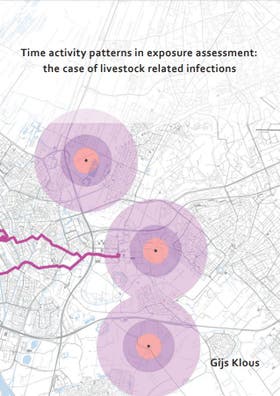Gijs Klous
Time activity patterns in exposure assessment: the case of livestock related infections

- Datum
- (Co) promotoren
- 17-09-2020
- Coutinho, R.A.; Heederik, D.J.J.; Huss, A.
Samenvatting
Summary Between 2007 and 2010 the Netherlands experienced the largest documented Q fever outbreak to date. This outbreak and several other incidents with infectious disease spill-overs from livestock to humans, initiated research focussing on the impact on human health of living in the vicinity of livestock farms. In this thesis, information about outdoor activities -mobility and activities outdoors near the home- were collected using GPS logging and self-reporting, in a rural population in the Netherlands. This was performed to include a measure for duration and frequency of exposure to exposure assessment methods for livestock related infections. Outdoor activity patterns were combined with data about livestock farms in the research area, which acted as exposure source. Time spent outdoors close to home in the presence of goat farms translated into an increased pneumonia risk. The specific agent or mechanism underlying this increased risk for pneumonia was not identified and is currently under study. Mobility outdoors in the vicinity of goat farms did not markedly change risk estimates, but this might be expected given that the time spent on active mobility was relatively limited. Still, it was observed that outdoor exposure, a combination of time spent outdoors near the home and active mobility, contributed to the risk of becoming C. burnetii serology positive during the 2007-2010 Dutch Q fever outbreak. These associations were stronger if people lived closer to C. burnetii positive farms. Given these findings, time activity patterns, when included to exposure assessment, provided somewhat stronger associations, than for measures earlier used in spatial epidemiological studies such as home distance from the source. Time spent in the vicinity of an emitting infectious source is likely to play a role in exposure assessment to livestock related zoonotic pathogens and information about time activity data should therefore be considered for exposure assessment methods. The method how to include this factor is a topic for further study. It was shown that study participants significantly overestimated their time spent outdoors in active transport when self-reported data were compared to GPS measured data, but several general characteristics correlating to differences in mobility patterns were identified. Using this information, three different approaches were designed to predict active mobility for exposure assessment. These estimation methods however, were equally unable to accurately predict active mobility, when compared to matching GPS data. Measurements therefore, still represent the best possible tool to evaluate outdoor activity and active mobility. Given the identified associations in this thesis, in the event of a future livestock related outbreak of a zoonotic disease, depending on the causal pathogen, active mobility and outdoors activities should be limited in the vicinity of infected farms. Among residents living near future infected farms, health and time-activity data should be collected, this will provide additional data that may strengthen the findings in this thesis.
